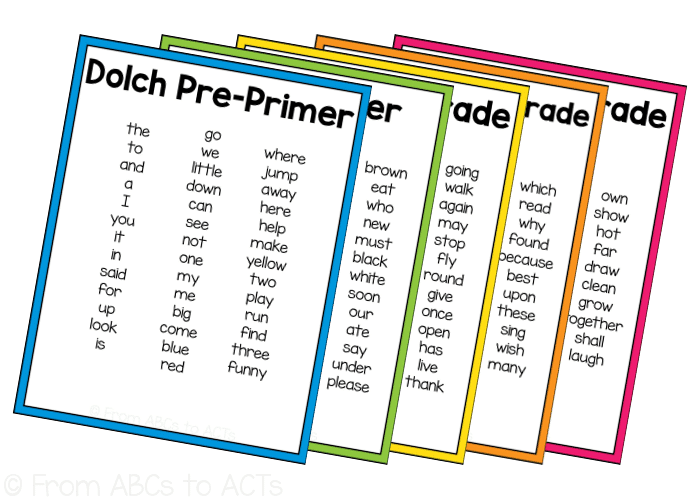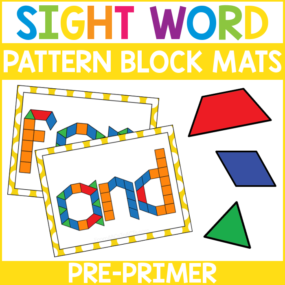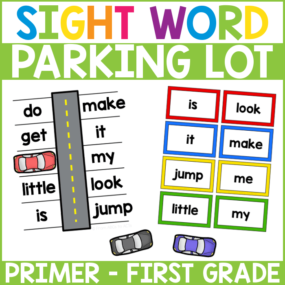This post may contain affiliate links. For more information, please see my full disclosure policy.
Dolch sight words have been around for a number of years.
First compiled by Dr. Edward William Dolch and published in 1936, these high frequency words were meant to be recognized by sight as this would help with reading fluency.
But even with a compiled list of words, it can still be an overwhelming task to figure out how and in what order to teach them.
With these Dolch sight word lists, however, we’ve taken out some of the guesswork by organizing each list in frequency order!

Why Teach Sight Words?
Before we get to the lists themselves, it may help to understand why sight words are so important.
When we’re teaching students to read, we’re working on a number of different concepts that will help them sound out the words that are in front of them.
They’ll learn the letters of the alphabet and the sounds that those letters make and as they progress, they’ll learn to sound out vowel teams and consonant blends.
But, what happens when they come across a word that doesn’t follow the typical phonetic rules like the, was, or of?
On the path of learning to read, words like these act like big stop signs since they can’t be decoded, meaning kids can’t sound them out.
And for those that can be decoded?
Well, if a student has to stop reading every time they come across the words it or is because they need to sound them out, their fluency and comprehension would suffer greatly.
Teaching sight words like those in the Dolch word lists ensures that your students will not only read more fluently but that they’ll retain and comprehend more of what they read as well.
Dolch Sight Words
Dolch words are basic sight words typically the ones that most people know of, although there are other lists out there.
The Fry lists are also fairly common and my own personal preference when it comes to teaching sight words.
In my opinion, the Fry words are much more comprehensive as they cover a larger number of high-frequency words and common words and they are more up-to-date than the Dolch sight words.
The Dolch word list does, however, include 220 words, sometimes known as high frequency words sight words, that are broken up into six different lists:
- Pre-Primer (Pre-K)
- Primer (Kindergarten)
- First Grade
- Second Grade
- Third Grade
- Dolch Nouns
Dolch Sight Word Lists
Each Dolch sight word list corresponds to a particular grade level, but by no means should a child be rushed through the lists to make sure they match up. Each child will learn at their own pace and establishing a solid foundation in sight words will set them up for success as they progress in learning to read.
Pre-Primer
- to
- and
- a
- I
- you
- it
- in
- said
- for
- up
- look
- is
- go
- we
- little
- down
- can
- see
- not
- one
- my
- me
- big
- come
- blue
- red
- where
- jump
- away
- here
- help
- make
- yellow
- two
- play
- run
- find
- three
- funny
Primer
- he
- was
- that
- she
- on
- they
- but
- at
- with
- all
- there
- out
- be
- have
- am
- do
- did
- what
- so
- get
- like
- this
- will
- yes
- went
- are
- now
- no
- came
- ride
- into
- good
- want
- too
- pretty
- four
- saw
- well
- ran
- brown
- eat
- who
- new
- must
- back
- white
- soon
- our
- ate
- say
- under
- please
First Grade
- of
- his
- had
- him
- her
- some
- as
- then
- could
- when
- were
- them
- ask
- an
- over
- just
- from
- any
- how
- know
- put
- take
- every
- old
- by
- after
- think
- let
- going
- walk
- again
- may
- stop
- fly
- round
- give
- once
- open
- has
- live
- thank
Second Grade
- would
- very
- your
- its
- around
- don’t
- right
- green
- their
- call
- sleep
- five
- wash
- or
- before
- been
- off
- cold
- tell
- work
- first
- does
- goes
- write
- always
- made
- gave
- us
- buy
- those
- use
- fast
- pull
- both
- sit
- which
- read
- why
- found
- because
- best
- upon
- these
- sing
- wish
- many
Third Grade
- if
- long
- about
- got
- six
- never
- seven
- eight
- today
- myself
- much
- keep
- try
- start
- ten
- bring
- drink
- only
- better
- hold
- warm
- full
- done
- light
- pick
- hurt
- cut
- kind
- fall
- carry
- small
- own
- show
- hot
- far
- draw
- clean
- grow
- together
- shall
- laugh
Dolch Nouns
- apple
- baby
- back
- ball
- bear
- bed
- bell
- bird
- birthday
- boat
- box
- boy
- bread
- brother
- cake
- car
- cat
- chair
- chicken
- children
- Christmas
- coat
- corn
- cow
- day
- dog
- doll
- door
- duck
- egg
- eye
- farm
- farmer
- father
- feet
- fire
- fish
- floor
- flower
- game
- garden
- girl
- goodbye
- grass
- ground
- hand
- head
- hill
- home
- horse
- house
- kitty
- leg
- letter
- man
- men
- milk
- money
- morning
- mother
- name
- nest
- night
- paper
- party
- picture
- pig
- rabbit
- rain
- ring
- robin
- Santa Claus
- school
- seed
- sheep
- shoe
- sister
- snow
- song
- squirrel
- stick
- street
- sun
- table
- thing
- time
- top
- toy
- tree
- watch
- water
- way
- wind
- window
- wood
While these lists include both regular, or decodable, and irregular, or non-decodable, words, they’re often listed in alphabetical order, making it difficult to determine the order in which to teach them.
For our free resource, however, we’ve organized each of them in frequency order (all except for the nouns list), meaning those words at the beginning of each list are those that will appear most frequently in your students’ reading in most children’s books. The list of Dolch nouns, however, remains in alphabetical order as these words are all fairly common and can be found in a number of children’s books regardless of grade level.
Working these sight words into your lesson plans first allows your new readers to hit the ground running.

Teaching Dolch Sight Words
Teaching the words on the Dolch sight word lists is much like teaching any other type of sight word.
Above all, they all require practice.
Lots and lots of practice!
But that practice can look different for every child.
There isn’t one way that works for every child, every time.
In fact, you’ll probably need to try several different approaches before you find the ones that work best for your students.
These could include reading simple sight word books, playing a few sight word games (I Have, Who Has? makes a fantastic practice activity for the whole class), or even finding ways to incorporate movement into their sight word learning.
But, no matter what you try, it’s important to remember that every child will learn in their own way and in their own time.
Your job is to simply guide them along and make the process as interesting and engaging as possible.



